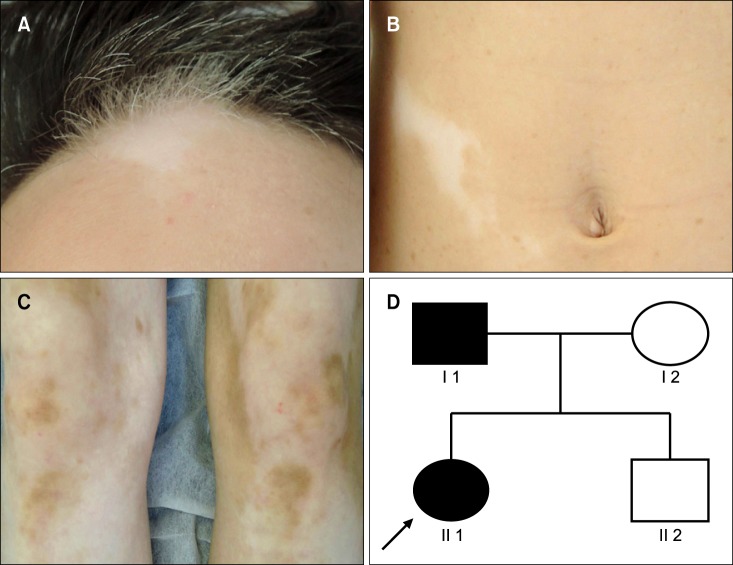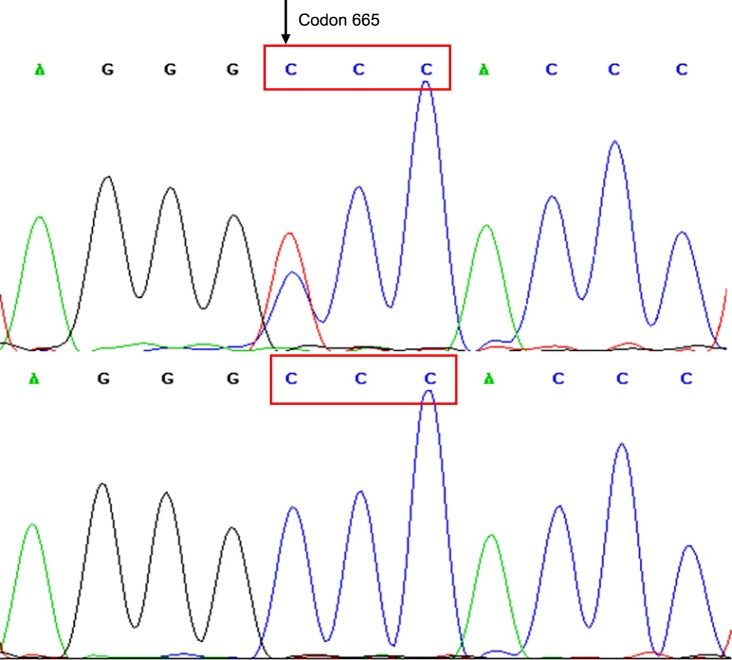Dear Editor:
Piebaldism (OMIM #172800) is a rare autosomal dominant disorder characterized by stable areas of amelanotic skin and a white forelock. Piebaldism is thought to result from defective proliferation or migration of melanocytes from the neural crest during development1. According to the depigmented patchces, piebaldism can be presented in mild, moderate and severe conditions. The mild type may only show a white forelock or smaller leukoderma on the ventral trunk and/or an extremity without a white forelock. The severe form shows a typical white forelock on frontal scalp and relatively large leukoderma on the chest, abdomen, and extremities. The moderate phenotype is the intermediate type of these two forms2. Missense and frameshift mutations of the KIT gene are responsible for a range of phenotypes with piebaldism.
We collected one Chinese family with piebaldism. The proband, a 16-year-old girl, born with a white forelock, irregular 1~5 cm-sized white patches on her abdomen and mutiple large areas of white patches asymmetrically scattered over both knees with intrapatch freckling (Fig. 1A~C). Her father showed similar lesions. The other members of this family were normal. Based on clinical phenotype classification of piebaldism, a severe form of piebaldism was defined.
The family members voluntarily joined the genetic screening after informed consents were obtained. All exons, exon-intron flanking regions of KIT gene were analyzed by polymerase chain reaction and Sanger sequencing. A novel heterozygous missense variant (c.1993C>T, p.P665S) of KIT gene was identified from the proband and her father (Fig. 2). This mutation was absent in her mother and brother and 100 unrelated healthy people as well. By PolyPhen-2, this mutation was predicted to be probably damaging with a score of 0.999 (sensitivity: 0.09, specificity: 0.99). All of these results supported that this mutation probably had pathogenic significance.
Generally, loss of functional mutations of KIT gene is responsible for almost all cases of piebaldism. The cytoplasmic region of KIT contains a juxtamembrane domain and a TK (tyrosine kinase) domain that is subdivided into a TK domain 1 (TK1), a kinase insert domain and a TK domain 2 (TK2)2. The severe phenotypes of piebaldism usually result from mutations involving the intracellular tyrosine domain, whereas the mild phenotypes are usually caused by mutations involving the amino-terminal extracellular ligand binding domain3. Wasag et al.4 demonstrated that one mutation (p.T619A) in the TK1 domain led to much weaker phosphorylation level of KIT protein than wild type KIT. In addition, one mutation (p.G664R) was demonstrated to cause severe phenotype of piebaldism5. As the novel mutation (p.P665S) is in the TK1 region and adjacent to the above missense mutation, we infer that this mutation (p.P665S) may probably affect the autophosphorylation of KIT and thus result in significantly decreased proliferation and migration of melanocytes in the lesions.
In summary, a novel missense mutation (p.P665S) in TK1 region of KIT was reported in a Chinese family with severe piebaldism. Mutations in cytoplasmic TK region are mostly associated with severe phenotypes; however, the pathogenicity of this variant remains to be fully elucidated.
ACKNOWLEDGMENT
A grant from National Natural Science Foundation of China (81371724) to Yanhua Liang.
All persons who have made substantial contribution, but who are not eligible as authors are named in acknowledgment.
References
1. Spritz RA, Holmes SA, Ramesar R, Greenberg J, Curtis D, Beighton P. Mutations of the KIT (mast/stem cell growth factor receptor) proto-oncogene account for a continuous range of phenotypes in human piebaldism. Am J Hum Genet. 1992; 51:1058–1065. PMID: 1384325.
3. Lennartsson J, Rönnstrand L. Stem cell factor receptor/c-Kit: from basic science to clinical implications. Physiol Rev. 2012; 92:1619–1649. PMID: 23073628.

4. Wasag B, Chmara M, Legius E. Molecular characterization of two novel KIT mutations in patients with piebaldism. J Dermatol Sci. 2012; 66:78–79. PMID: 22264755.

5. Giebel LB, Spritz RA. Mutation of the KIT (mast/stem cell growth factor receptor) protooncogene in human piebaldism. Proc Natl Acad Sci U S A. 1991; 88:8696–8699. PMID: 1717985.





 PDF
PDF ePub
ePub Citation
Citation Print
Print




 XML Download
XML Download